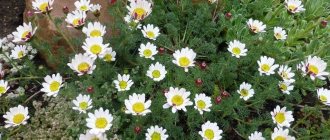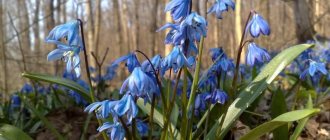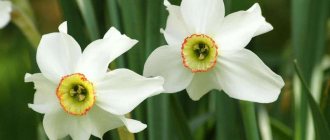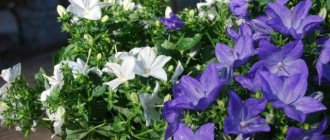Peonies are lush and beautiful flowers that can decorate a garden plot. But they require sufficient growing experience and a lot of time. Without observing the watering regime, regular feeding and timely replanting, the bushes quickly lose their decorative appearance. Good replacements for those who want easy-care flowers similar to peonies are peony rose, ranunculus and carnation. These plants do not belong to a related species, but are similar in appearance.
In the article we will talk about the features of flowers that look similar to peonies: the characteristics of the plant, the subtleties of growing and what it is suitable for.
Peculiarities
The name of the variety “aster” has Greek roots and means “star”. Indeed, wonderful flowers are similar to heavenly bodies, but the color palette of “earthly stars” is much wider. Even legend says that asters appeared from star dust that fell from the very heavens. Peony aster is a genus of perennial bush plants with a powerful root system and large flowers. The bush itself belongs to the medium-sized species and grows up to 70 cm in height. Its stems are not too branched and erect, side shoots grow extremely rarely, which allows it to well maintain its columnar shape.
The flowers of the peony aster are very similar in shape to peonies, which is why the plant got its name. The inflorescence is presented in the form of a terry basket with short inner petals and longer outer ones. Resembling tongues, they are directed towards the bright yellow center, which is why the flower takes on a shape similar to a colored ball. The diameter of the flowers can be from 8 to 15 cm, and the color can be white, burgundy, pink-violet or yellow. The aster delights its owners with flowering from mid-summer until the end of September. They often bloom magnificently and brightly, while exuding a pleasant and pungent floral aroma. The plant gets along quite well with other flowers in the neighborhood, and therefore can be an excellent addition to a flower bed.
Characteristic signs of cloves
Flowers can grow either singly or in groups of 2-3. The flower calyxes are usually cylindrical with several pairs of bracts. The petals are velvety with fringed plates. Absolutely anyone can color them.
Cloves have medicinal properties
The fruit of the clove is an elongated capsule with many black seeds that are round, oval or flattened. The leaves are green, grass-like, and can be colored in different shades of green. Carnations are great for borders and rock gardens, flower beds and retaining walls.
Pink peony roses
These varieties are the most common in the world. The buds can be different shades of pink, cream and even peach.
Constance Spry
This is one of the first varieties of bush peony rose bred by David Austin; the photo does not convey the versatility of the shades of each of its inflorescences.
The culture grows up to 4 m, under favorable conditions up to 6 m. It can be used as a climbing plant and can be used to decorate vertical structures. The bush needs support, as the shoots are weak, droop down, and do not hold their shape.
Peony inflorescences are large, up to 13 cm in circumference, double, cup-shaped. There are a lot of them on the bush; during the flowering period it becomes all pink. The petals on one bud can be pale pink, almost white or bright, caramel pink. During the flowering period, peony-shaped inflorescences emit a strong aroma of myrrh.
The shoots are thin and long, covered with a large number of spines. The leaves are large, light green, matte. Greenery densely covers the entire surface of the shoot.
The culture adapts well to cold climates - it blooms luxuriantly and reproduces well.
Keira
The inflorescences of this variety look like in old paintings; it is considered the most successful creation of David Austin. It was recently released in 2009.
The buds are medium-sized, 10-13 cm in circumference, thick, terry, barely perceptible pink, almost creamy or peachy in the center and lighter at the edges. The petals are large, wavy, matte, tousled, and there are up to 100 of them in one inflorescence. The aroma is weak.
The shape of the bush is regular, spherical, with a girth of approximately 80 cm. The shoots are smooth, erect, densely covered with large dark green leaves. The bush does not grow more than 1.5 m.
Juliet
This peony hybrid has medium (no more than 13 cm in circumference) peach-pink inflorescences. They are dark in the center, white and pale pink at the edges. The inflorescences are voluminous, each with 80 to 100 petals. Only one bud is formed on each shoot.
The shrub is low, grows up to 1 m 20 cm in height and up to 70 cm in width. Flowering lasts for a long time - from early May to September. The plant is resistant to diseases and pests. Requires shelter for the winter.
Miranda
The shoots are short - up to 40 cm, with one inflorescence formed on each. The buds are small but lush, not exceeding 8 cm in diameter. The shape is classic, the petals are curly, wavy, large, densely intertwined with each other. In the center the inflorescence is bright pink, closer to the edge it is pale pink with a greenish border. When fully expanded, it acquires a regular, round, cup-shaped shape.
Rosalinda
The large flower of this variety is shaped like a peony. Its diameter ranges from 12 to 14 cm. The bush is densely dotted with single creamy-pink peony-like inflorescences. When closed they are almost beige, but when opened they become beige-pink.
The leaves are small, round, slightly elongated, jagged, dark green in color. The shoots are low, up to 0.4 m in length, densely dotted with greenery.
Description of peony rose
Peony roses were bred by the famous breeder D. Austin at the end of the last century. That's why they were originally called Austin roses. These extraordinary shrubs differ from other representatives of the species by their unsurpassed beauty, variety of colors, resistance to various diseases and pests, as well as high decorative qualities.
Flowers that look like peonies are quite unpretentious. The shrub grows quickly without requiring additional feeding or special care. Many varieties are successfully grown in greenhouses, creating an excellent alternative to peonies throughout the year.
Peonies and peony roses themselves are very similar in appearance. Some varieties even have an identical structure, especially when it comes to the flower itself. But they still have differences. As a rule, peony roses have a rosette, pomp-shaped or cup-shaped inflorescence. Some varieties have a stunning, refined aroma that intensifies in cloudy weather.
The bush grows quickly, forming a dense crown with bright fragrant flowers. Roses similar to peonies, the names of which are listed below, are widely used for landscaping park areas, gardens and summer cottages, creating wedding bouquets, and also as decoration when decorating a hall for celebrations.
Varieties of roses similar to peonies
Among the numerous varieties and varieties of these beautiful flowers, the most popular ones can be noted. These plants are most often used to create unique bouquets, as well as landscape design. Roses, like peonies, whose names are known to most gardeners, are extremely popular.
What are the names of roses that look like peonies?
- Constance Spray. This is the very first hybrid of a peony-like rose. It has large, pale pink, cup-shaped flowers. The shrub is vigorous, its height can reach 4 meters, which allows the plant to be used as a hedge, running it along a low fence, wall or support. The bush is abundantly covered with huge flowers, which never fully open, remaining in the state of a half-bud. The plant has matte pale green foliage and frequent small thorns.
- Othello. It has densely double large flowers, painted in a rich crimson color, which over time turns into purple-lilac. At the same time, the inflorescences look so dark that it is not difficult to imagine why this rose variety received this name. A medium-sized shrub with a large number of thorns, it is characterized by repeated flowering and does not tolerate heat. Flowers collected in brushes remain fresh for a long time, so they are often used for cutting.
- Pat Austin. The variety grows well in partial shade and is resistant to cold. Large semi-double flowers are painted in a bright copper color, gradually turning into a soft cream shade. Flowering begins early, continues continuously and for quite a long time. The aroma is reminiscent of rose oil.
- Austin Gertrude Jackipp. A vigorous bush rose, characterized by abundant and long-lasting (from May to November) flowering. The aroma is reminiscent of old roses with delicate notes of myrrh. Bright pink double flowers, evenly distributed throughout the bush, completely cover it. The variety is distinguished by its full flowering and decorative appearance. The plant is resistant to various diseases and tolerates winter well. An adult bush reaches a height of 250 cm, its diameter is about 1 meter.
- Benjamin Briten. The beautifully leafy shrub reaches a height of 1.4 m (under favorable conditions - up to 2.0 m). Raspberry flowers with a diameter of about 12 cm exude a pronounced fruity aroma. Densely double buds, collected in inflorescences, have a cup-shaped shape. Even weakly flowering plants of this variety look very powerful. Peony roses are highly resistant to pests and various diseases. Recommended for growing in flower beds, where it is possible to cross them with other varieties to obtain a more delicate shade.
- William Shakespeare. The bush is distinguished by peony-shaped flowers that exude the scent of ancient roses. The height of the plant reaches 180 cm. The shrub grows well in the shade and is unpretentious in care.
- Brother Cadfil. Among other English varieties of peony roses, it stands out for its rather large pink flowers. Looks very impressive in the center of the composition. The impressively sized flowers retain their freshness for a long time and look quite neat. Rose Brother Cadfil is proportionally built and practically devoid of thorns.
Peonies and ranunculus: differences and similarities
Who would have thought that the Asian buttercup could compete with the royal double flower. But in floristry everything is possible. Especially Dutch unopened peonies resemble ranunculus. Both plants have dense, round buds.
Blooming ranunculi are approximately 6 cm in diameter.
On the one hand, this is not much compared to 10-12 cm for peonies, but they are cheaper. Buy a few dozen of them and you'll end up with a huge armful. For a girl, this can be a truly original and unusual gift. According to the observations of Semitsvetik florists, men often give familiar flowers; for them, ranunculus is an exotic thing that they underestimate.
Ranunculus
Asian buttercup, garden buttercup, ranunculus - whatever they call this flower, which blooms in flower beds in June-July. In Eastern Europe, this crop is not very common, due to the fact that it does not look like an ordinary wild buttercup, and sometimes it is easily confused with the common peony. Today, more than 600 species of ranunculus are known, which are suitable for growing in pots, on terraces and, of course, in open ground.
Tightly closed ranunculus flowers can stand in water for up to 10-14 days
Peony roses in landscape design
Flowers are a wonderful decoration for any garden or flower bed. Many types of peony rose can be grown as a climbing crop. In this case, the plant can decorate an arch or gazebo.
The bright and lush inflorescences of bush peony hybrids do not tolerate the proximity of other flowering crops. Rose will be the soloist in this composition.
To highlight the beauty of the peony plant, a rose garden is planted in the garden. It uses several types of Austin English bush roses. The rose garden is made in the form of a flower garden; varieties are separated into sections, which can be separated by stone paths. In the photo you can see how to simultaneously decorate an arch and a flower bed in the garden by planting a peony rose.
Peony roses look good against the background of a fountain, artificial pond, swimming pool, antique sculpture or arch.
To emphasize the tenderness and beauty of the peony rose, it is planted against the background of coniferous and evergreen plants.
Flowers that look like peonies
Daisy-like flowers
In nature there are many plants similar to peonies. Here are the names of some flowers that look like peonies.
Roses
Peony roses were bred by the English breeder David Austin. Roses, like peonies, are called “ostinki”. They are very decorative: they bloom profusely in a variety of shades. This rose grows quickly and does not require special care.
Peony roses
Ranunculus
This flower is similar to peonies and roses at the same time. Ranunculus has lush buds of various shades: from pastel to bright, saturated. It blooms from June to August, some species even until mid-autumn. Its height varies from 20 to 80 cm.
Note! Ranunculus must be handled very carefully as its juice is poisonous.
Carnation
Some varieties of carnations are also similar to peonies. It can be short (up to 10cm) and tall (up to 60cm). Its flowers are formed singly and in groups. Carnations can bloom for 3-4 months, becoming a flowerbed decoration. The carnation that looks most like a peony is the Chabot carnation.
Carnation Shabo
Tulips
Tulips with double petals are called peony-shaped. They are early, mid and late flowering. The names of the most popular varieties: Abba, Zizania, Orange Princess, Miranda, Angelica.
Asters
The inflorescence of asters consists of reed petals directed towards the center, which makes them look like a peony. They have a varied palette from white to dark purple shades. The buds begin to open in early August and finish at the end of September.
Asters
Eustoma
This plant looks like several flowers: rose, bellflower, and also peony. The varieties with white and pink petals that are in full bloom (Aurora, Lisianthus grandiflorum) are especially similar to it.
Chrysanthemum
Another flower similar to peony and rose is the grandiflora chrysanthemum (some of its varieties). These are tall, showy, autumn bushes. The buds reach a diameter of 25 cm. These flowers are intended for cutting.
- https://stroy-podskazka.ru/cvety/pionjvidnie/
- https://7ogorod.ru/cvety/pohozie-na-piony.html
- https://flowerprofi.ru/sadovye/kakie-est-tsvety-pohozhie-na-piony.html
- https://fb.ru/article/194924/tsvetok-pohojiy-na-pion-kak-nazyivayutsya-tsvetyi-pohojie-na-pionyi
- https://rastenia.info/tsvetyi/roza/pionovidnye.html
- https://landshaftadvice.ru/pionovidnye-rozy/
- ← How to properly dry mint at home
- Drawing of a gazebo made from a profile pipe, how to weld the structure yourself →
Tips from experienced summer residents
Having been growing plants for a long time, flower growers have gained some experience, which they share with beginners. Here are some tips from them:
- If flowers are grown as cut flowers, then the side branches and buds are removed so that all the strength and nutrition goes to the main shoot.
- To obtain earlier growth and flowering, seeds are sown and cuttings are rooted in late February or early March indoors.
- The distance between the bushes should be large enough. With frequent planting, ventilation becomes difficult, and this threatens the appearance of fungal diseases.
Flowers similar to peonies can be planted in a flowerbed or mixborder together, or in monochrome; another option is to combine them with other plants that are unlike them. Be that as it may, they will always be a bright decoration of the garden.
Sources:
https://www.bolshoyvopros.ru/questions/1948356-kakie-est-cvety-pohozhie-na-piony.html https://stroy-podskazka.ru/cvety/pionjvidnie/ https://flowerprofi.ru/sadovye /kakie-est-tsvety-pohozhie-na-piony.html https://7ogorod.ru/cvety/pohozie-na-piony.html
Growing
Peonies can grow in one place for a long time. The place is chosen to be sunny. Peonies are not dug up for the winter; they easily tolerate frost. They usually begin to bloom in the third year after planting. For this reason, they should not be replanted frequently.
The place is chosen to be sunny
In this, peonies and peony roses are similar. They also should not be replanted frequently. Roses may bloom next year, but this cannot be given to them: the buds are torn off so that all the energy goes into building up the root system. The landing site should be well lit by the sun. For the winter, peonies and roses bury themselves and cover themselves.
Important! In order for the rose to grow strong side shoots that will bloom, faded buds must be removed. Bulbous, similar to peonies (daffodils, tulips) bloom the following spring after planting
In the summer, after flowering, the bulbs are dug up and planted again in mid-autumn. Since the bulbous flowers bloom first, they are well lit by the sun wherever they are planted.
Bulbous, similar to peonies (daffodils, tulips) bloom the following spring after planting. In the summer, after flowering, the bulbs are dug up and planted again in mid-autumn. Since bulbous plants bloom first, they are well lit by the sun wherever they are planted.
Asters are annuals. Their entire life cycle runs from the beginning of spring until frost. Then the flower dries up and seeds are collected from it for further propagation. The next year they are sown, and the life cycle begins anew. Aster is unpretentious to the composition of the soil, but the lighting should be bright. Otherwise, the stems will be thin and elongated.
Eustoma is a biennial. In the first year it forms a rosette and blooms a year later. For the winter, the eustoma must be carefully mulched and covered. In colder regions, it is dug up and planted again in open ground in the spring. Reproduces only by seeds. The soil for eustoma should be light, well-drained.
Chrysanthemums are perennials. They are easily propagated by shoots and cuttings. They begin to bloom in autumn. For the winter they must be hilled and covered. In harsh climates, the roots are dug up and stored in a cool place until spring.
Note! In order for chrysanthemum buds to grow large, the plants need to be pinched. The Shabot carnation, which is most similar to a peony, is also dug up for the winter, since it can freeze out from severe frosts
Easily propagated by seeds, prefers to grow in a well-lit place
The Shabot carnation, which is most similar to a peony, is also dug up for the winter, since it can freeze out from severe frosts. Easily propagated by seeds, prefers to grow in a well-lit place.
Ranunculus is planted in a slightly shaded area in the spring, when the threat of frost has passed. In the fall, the root is dug up for storage from the cold. Ranunculus can be grown indoors. Several bushes in one pot will look more impressive.
In order for green spaces to grow beautifully, with powerful stems, bright and large buds, they need to be properly cared for.
- Watering the plants should be regular, as the top layer of soil dries out.
- Loosening the soil after watering will ensure its aeration and air access to the roots.
- Mulching will retain moisture in the soil and ensure its breathability.
Mulching will retain moisture in the soil
- In the spring, the first feeding of the plantings is done with nitrogen fertilizers, for example, rotted manure. If, when planting perennial plants, any nutrients were poured into the hole, then in the year of planting they are no longer fed.
- Bushes with long vines need support and garter.
- To stimulate the growth of side shoots, after flowering the buds are removed from the bush.
- When signs of disease appear, the bushes are sprayed with appropriate preparations. The same thing happens when bushes are damaged by various pests.
Care
There are quite a few different flowers that look very similar to peonies, but are not. You need to be able to distinguish between them in order to decide what care and necessary conditions to create, since they may differ. Peonies can grow for a long time without transplanting, especially if the place is well lit. After planting, you need to pick off the developing buds to create a strong root system. To grow strong side stems that will bloom in the future, faded buds must be removed without fail.
For wintering, roses, like peonies, are well covered, leaving them in the ground. Bulbs (peony-like daffodils and tulips) begin to bloom in the coming spring after planting. At the end of flowering (in summer), the bulbs are dug up, and in mid-autumn they are replanted.
Asters belong to annual crops; their life cycle begins in early spring and ends with the onset of frost. When the inflorescence dries, the seeds are selected for subsequent propagation. In the spring they are sown, then the cycle begins again. In general, the Chinese peony aster is a picky plant, but it needs bright light, otherwise the stems will be too thin.
Eustoma is a biennial plant. In the first year of life it forms a rosette, and begins to bloom the next year. In winter, it needs thorough shelter or digging. In the spring it is planted again on the site. The soil needs to be light, with good drainage. The flower reproduces only with the help of seeds. Chrysanthemums overwinter in open ground, but require good cover.
The “Shabo” carnation is also dug up for the winter; it does not tolerate frost well. Well-lit areas are suitable for planting. Ranunculus is planted in a shaded area after the threat of frost. In autumn, the roots are dug up and stored in cool rooms. This plant is also grown as a houseplant; a lush bush of several specimens in one container looks beautiful. In order for the plants to have a healthy and strong appearance, and for the buds to be bright, they need to be provided with the necessary care:
- regular hydration;
- loosening the soil to allow air access to the roots;
- mulching to retain soil moisture;
- spring fertilizing with nitrogen fertilizers;
- garter of elongated plants;
- cutting off faded buds to stimulate the formation of lateral stems;
- At the first signs of disease or pest damage, plants are treated with special preparations.
Experienced flower growers advise trimming side shoots and inflorescences if the flowers will then be cut. Then the plant will concentrate all its forces on the main stem. Flowers similar to peonies look spectacular in flower beds, mixed borders or front gardens. They can be placed monochrome, but they also look great in compositions with other plants. No matter how peony flowers are planted, they will always be a charming decoration for any planting.
An overview of peony flowers can be seen in the following video.
Tulips that look like peonies
How many petals do spring primroses have - 5-7? No, peony varieties have more than 20 of them! Imagine how beautiful the bouquet looks when each bud opens several dozen colored petals
.
The first densely double tulips appeared more than 4 centuries ago, but still less than 10% of the market is allocated to these flowers. The idea of a tulip as a modest, non-fluffy plant is too firmly rooted. We encourage our readers to break stereotypes and enjoy peony tulips while the season of their large-double counterparts has not yet arrived.
Now you know what you can replace peonies with before their season comes.
It turns out that the choice is very large, and every month you can please your beloved with voluminous and bright compositions.
Peony season has begun
Discounts up to 40%!
—Categories
- Animals (299)
- lapotuli_krasotuli (175)
- animals_planets (62)
- wild sweets (40)
- world_birds (12)
- world_underwater (10)
- Army (28)
- useful, necessary (4)
- astrology (22)
- cognition (7)
- esoterics (12)
- House (393)
- knitting (58)
- holidays (6)
- on__ windowsill (41)
- vegetable garden, flower bed (59)
- with __ hands (111)
- tips for the home (68)
- comfort (29)
- sew_ (21)
- health (617)
- masks (87)
- folk recipes (296)
- spices (11)
- tips (189)
- Interesting: (952)
- cities__ (81)
- history_2 (13)
- interesting__ (199)
- history 41-45 (17)
- history_ (119)
- stones__ (17)
- legends, myths (28)
- invisible__ (26)
- educational_ (142)
- parable (20)
- miscellaneous_ (97)
- mystery__ (34)
- phenomena, mysteries (72)
- photo story (77)
- quotes, wisdom, aphorisms (30)
- Internet (327)
- internet_advice (97)
- online_lesson (51)
- programs_schemes (103)
- lessons_liru (76)
- Cinema Hall (147)
- documentary (31)
- melodrama, series (26)
- cartoons (2)
- history of __movie (11)
- history__actors (19)
- movies (58)
- books (44)
- Cooking (590)
- second (89)
- bake (181)
- blank (99)
- liqueurs (24)
- recipe (140)
- salad (18)
- kitchen tip (39)
- Music sounds (186)
- clips (11)
- history (7)
- melodies (14)
- songs (154)
- Cognition (670)
- for knowledge (129)
- for advice (42)
- for__soul (44)
- for__women (29)
- for__men (5)
- for__family (58)
- icons (17)
- prayers__ (39)
- verse (307)
- Photos (496)
- paintings_ (41)
- amazing_universe (15)
- amazing_underwater (41)
- amazing_close (199)
- _pictures (21)
- _jokes (93)
- _porcelain (24)
- _humor_jokes (62)
—Quote book
The strangest, funny and unusual breeds of domestic cats The strangest, funny and unusual.
The only product that kills viruses, fungus and bacteria at the same time! When mixing.
Cute faces who skillfully manipulate people! Hi all. Has it ever happened?
Why you can’t look a cat in the eyes - let’s understand cat language! Many fans.
The sad fate of the first cosmonaut dog, Laika. Today I would like a little .
-Statistics
Friday, August 05, 2021 15:27 + to quote book
It is impossible to imagine a beautiful and elegant bouquet without peonies. These luxurious and lush flowers are loved by many summer residents. But is it possible to plant some other plants on the site that will resemble the usual peonies and at the same time do not require care?
Peonies are one of the most luxurious and desirable flowers in any summer cottage. But it is believed that they are quite finicky to grow, and not all summer residents manage to keep them in a healthy condition, divide and replant them in a timely manner. Therefore, many find a replacement for peonies and choose flowers that at least superficially resemble their favorite crop.
General description of peonies
You can see peony flowers in many countries around the world. Which is understandable - they grow abundantly in Eurasia and North America, preferring subtropical and temperate latitudes. Even wild subspecies are often not very similar to each other, let alone the varieties bred by experts.
Simplicity and grace are the undoubted advantages of culture
How many subspecies are there?
Today the species includes 36 subspecies. Some are widespread and have long been cultivated by gardeners and breeders, but others (most often the least attractive in appearance) have not become widespread.
How many varieties have been selected?
New varieties of peonies appear almost every day. Therefore, it is not possible to name their exact number.
Interesting! The name of the flower "Peony Botan" comes from the name of the legendary doctor Pean, who knew how to heal people and even gods from terrible wounds.
Their approximate number is about 5200, namely: over 4664 herbaceous and more than 500 tree-like. Of course, they differ significantly in a number of factors: flower shape, color, size, etc.
Variety of colors
Many novice gardeners are interested in what color peonies are. It's not easy to answer this question! If only because the color range is simply huge! Varietal peonies can be white, pink, beige, red, raspberry, peach and others.
This culture is a decoration for any flower bed.
What do they smell like?
Of course, any flower connoisseur is interested not only in what peonies look like, but also in what they smell like. And here it is also impossible to give a definite answer. It largely depends on the variety, but the main smell is sweetish. For example, it has long been noted that burgundy peonies have a musky smell. Red varieties have a slightly sour aroma, like a good apple. And the smell of whites is fresh, like clean running water.
Description
Today, quite a lot of peony-like flowers are grown with different colors and textures of petals. Peony roses are becoming increasingly popular, although they appeared relatively recently. The bushes are distinguished by their beautiful decorative appearance: they look like roses in appearance, and their structure and shape, which can be double or semi-double, are very similar to peonies.
The choice of varieties is quite wide; the color of the buds can vary from soft pink to purple or orange. There are also variegated varieties. The flowers have a delicate, pleasant aroma. Flower growers pay tribute to this species for its minimal care requirements and excellent disease resistance.
- The Austin rose was bred by the English breeder David Austin. The plant forms both a familiar rose bush and also has ampelous, climbing forms. The buds are round, looking like a lush, multi-layered pompom. They come with a small and deep bowl. In appearance they are more reminiscent of a peony than a rose, but they differ from the first in their numerous color palette and aroma. The smell is not only pink, but there are also notes of citrus, peach, cloves, and oriental spices.
- May rose or brown rose hips form quite voluminous bushes with brown branches covered with thorns. The buds are cup-shaped, small in size and similar in flower shape to one of the wild species of peonies, “Maryin Root”. It blooms pink, although there are reddish-purple specimens.
- Sweet Juliet has a lush bud with many petals and an incredible aroma. Blooms all summer and early autumn.
- Eden Rose is distinguished by large double flowers with a delicate scent. Flowering lasts quite a long time.
Double mallow is a tall perennial with a large number of fluffy peony-like flowers with elongated petals in a wide variety of tones: white, pink, yellow, various shades of red and purple.
Due to its high decorative value, the plant is not only often planted in plots, but also used for cutting.
Terry begonia has inflorescences in the shape of a voluminous bowl with a diameter of about 15 cm, which is supported on a squat peduncle. Multi-layered buds bloom in white, pink, scarlet, amber or yellow.
The peony aster is the most beautiful representative of its family. It grows up to half a meter, the flowers are spherical with a diameter of about 10 cm, painted in different colors. The flower is valued for its long flowering time and immunity to diseases.
Thanks to its unusual appearance, Chinese aster makes beautiful bouquets that do not lose their freshness for 2 weeks.
Ranunculus or Asian buttercup is a perennial plant that prefers damp, marshy areas for growing. The stems can reach 80 cm, the peony-shaped buds have different color shades. Depending on the variety, they can be snow-white, pink, scarlet, yellowish, cherry, lilac, even a light green tone. They also differ in shape; there are varieties with terry, semi-double or densely double bowls. Due to its unusually elegant appearance, the flower is often included in wedding bouquets.
How did peonies appear?
Peonies gained fame several centuries before the new era in Greece, China, and Rome, not only as an ornamental plant, but also as a medicinal one.
The peony enjoyed enormous popularity in China in the 1st century AD. peony was actively used in folk medicine and cooking.
Peony is a favorite flower among the Chinese; it is a symbol of long-lasting love. In almost all Chinese legends, the spirit of the peony is a beautiful girl.
In India, Iran and Pakistan, the peony is considered a symbol of pride. In China, the peony represents the Yang principle - masculinity, light, love, luck, wealth, spring, youth, happiness and longevity, in Japan - a symbol of well-being and prosperity! Among eastern peoples, peony means “bashfulness” and “shyness.”
More than 30 varieties of peonies were known in China; especially rare ones were valued very expensively and were exchanged only for gold.
The name peony (Paeonia) comes from a Greek myth. The student of the healer Asclepius was called Paeon.
Legend has it that with the help of an unknown plant he performed amazing healings, even curing the god of the underworld Hades from the wounds inflicted on him by Hercules.
Peon received this plant from the hands of Apollo’s mother, the goddess of darkness Summer. The miraculous healing aroused envy in Asclepius, and he ordered the secret killing of Peon.
Hades, in gratitude, did not allow him to die, turning him into a beautiful flower, which since then bears his name and has beauty and healing properties.
Peonies are perennial plants; they form a bush that will decorate any garden plot.
If you have an empty plot, then peonies will wonderfully decorate it; plant them in groups.
Wherever you plant a peony, it will attract attention and become the main decoration. Peony looks great next to irises, bells, poppies, blue sage, asters and chrysanthemums
Peony sits beautifully next to irises, bells, poppies, blue sage, asters and chrysanthemums.
Peonies are very light-loving, so experts recommend planting them in sunny places, and the planting site should be well protected from winds and sharp drafts.
It is worth noting that it is better to buy peonies in early autumn; to select a healthy plant, there must be at least 3 buds on the tuber root.
This is interesting: How to feed roses during budding and flowering - let's look at it from all sides
Carnation
A perennial plant, some varieties of which are similar to peonies. In total, about 350 species of carnations are known, many of which are cultivated in Europe and Asia as ornamental plants. They are sometimes called the "divine flower" because the name "carnation" is believed to come from the Greek words for the god Zeus and the flower.
Carnation is considered a symbol of goodness, prosperity and fidelity
Features of breeding and care
Before the rose is planted on the site, it is necessary to ensure that the soil is well fertilized. It is better if it is compost or manure. Fertilizer should be placed in a planting hole in a layer at least 2 cm thick.
Since the plant has a developed root system, the planting pit must be spacious, with a diameter of at least 1 m and a depth of about 0.5 m. A pit that is not spacious enough will not allow the root system to grow normally, and the flower will have fewer shoots.
Rose bushes should be planted at a distance of about 0.5 m from each other. In order to subsequently obtain beautiful, dense thickets covered with a carpet of flowers, it is better to choose roses of the same variety for placement in one area.
Before planting, the roots of the plant must be treated with a special solution that stimulates growth. Plant the bushes to a depth of 10 cm. This will help them quickly adapt and easily tolerate freezing of the soil during the cold season.
Since the rose does not like waterlogging, it should be watered only after the soil has dried. But at the same time, pour no more than 5 liters of water under each bush, and it is better to do this in the evening, so that less moisture evaporates from the soil surface.
The plant needs additional feeding. They must be applied 3 times per season. The first time - in early spring, the second - in mid-summer. During this period, nitrogen fertilizers are used to stimulate plant growth. And the third - during the formation of buds. At this time, phosphorus-potassium fertilizers are applied. By the beginning of autumn, all fertilizing should be stopped.
Bushes should be pruned in early spring to encourage active bud break. The branches are cut to a third of their length. During the entire growing season, it is necessary to free the plant from old and diseased shoots, as well as dried flowers. By the end of autumn, all immature shoots are removed. For the winter, the bushes are covered with spruce branches, straw, sawdust or leaves. This will provide the plant with the necessary protection from severe frosts. If the winter promises to be very cold, then you can build a small hut of straw over the bush and cover it with leaves or soil.
How to plant ranunculus
Garden ranunculus grows well in bright sun, but still prefers partial shade. The soil should be neutral in composition, light and fertile (loam will not work). The plant will need good drainage, so add some sand to the bottom of the hole. Don’t forget to add compost and treat the soil with a solution of foundationazole (1 g per 1 liter of water).
Ranunculus seeds are sown for seedlings in mid-February, laying them on the surface of light fertile soil and sprinkling with a 1-2 cm layer of soil. Then the container is covered with film or glass and placed in a well-lit place at a temperature of 15-17°C. 2-3 weeks after the emergence of seedlings, the cover is removed, and after two true leaves appear, the seedlings are planted in separate pots and planted in the ground.
What flowers are there that look like peonies?
Ranunculus
Ranunculus, or Asian buttercup, is a wonderful counterpart to the peony. This plant is up to 80 centimeters high, with bright green leaves of dissected shape. Lush flowers with a diameter of 5-10 centimeters have a color characteristic of peonies - from soft pink to purple. White ranunculus is also found. Thin petals surround light green stamens in the center of the flower.
It blooms in June-July; some species decorate flower beds until autumn frosts. Features of growing ranunculus:
- grows well in sunny areas, but prefers partial shade;
- the soil is preferably light and fertile (sand drainage will be required);
- The easiest way to grow is by seedling method, sowing seeds in February;
- Seedlings are planted in open ground at the end of April or in May.
Suitable for growing in open ground, in pots and as a decorative element for closed terraces. An important point - ranunculus juice is poisonous
When working with these plants, you need to be careful, as when cutting them for bouquets.
Peony roses
Another flower that simultaneously resembles a peony and a rose is called a peony rose. This fragile plant reaches
- grows abundantly in width, forms a large number of lash-like shoots;
- the flowers have a pronounced cup-shaped, pomp-shaped or rosette shape;
- in cloudy weather the flowers emit a faint pleasant aroma.
The most popular varieties of peony roses among gardeners are:
- Rose de Mai, also known as the May rose. A decorative variety of rose hips with a delicate aroma. Rose oil is obtained from the flowers.
- Austin Rose. The flowers are slightly smaller than those of the peony, with a pronounced aroma. Blooms 2 times a year.
- Sweet Juliet. Lush, multi-layered inflorescences of soft pink color. After the buds open, they release a delicate aroma.
- Eden Rose. The variety is distinguished by its unusual double appearance of inflorescences. Blooms from spring to early autumn.
Most varieties of peony roses grow well both in open and closed ground. When grown in a greenhouse, they can replace peonies all year round.
peony poppy
Terry peony poppy, or papaver, is an annual plant that is specially bred as an imitation of peony. The flowers are smaller, with many thin petals. Lush bright pink inflorescences resemble peonies in shape and color. This is a single flower on a long and thin stem, up to 1 meter high. It is unpretentious to growing conditions and does not require complex care.
Features of growing peony poppy and caring for it:
- grown as an annual (when planted before winter it can continue to grow as a self-seeding plant);
- grows well in a sunny, open area;
- due to the taproot system, the soil layer must be deep enough;
- propagated by seeds or root cuttings;
- It is recommended to sow seeds in open ground in early spring;
- the plant needs to be provided with regular feeding (preserves the bright green color of the leaves);
- the soil around each flower must be loosened regularly and then covered with mulch;
- Watering is moderate; it is not advisable to allow the soil to dry out.
The distance between neighboring flowers is at least 20 centimeters. The plant does not like crowded spaces, which is why it needs to be thinned out regularly and weeds removed in a timely manner. Peony poppy is grown for cutting. Used as an element of the Moorish lawn, ridges and mixborders.
Carnations
Terry varieties of garden carnations resemble peonies in appearance. Translated from Greek, carnation means “flower of Zeus.” Flowers grow singly or in bushes, with 2-3 inflorescences on each. The flowers are lush, velvety, with a terry border along the edges of the plates. The color can be almost any. The leaves are green, with an unusual grass-like shape.
Features of growing cloves and caring for them:
- propagated by seeds and layering;
- there are annual and perennial varieties;
- perennials are replanted every 5 years;
- Feeding with humus is applied once a year, after flowering;
- grows well at higher elevations;
- Watering is moderate, the plant does not like excess moisture.
Carnations are grown not only for cutting. They are used as a design element for rock gardens, borders and retaining walls.
Peonies are beautiful and bright flowers, but rather capricious to grow. But there are more unpretentious plants that are similar in appearance. These include peony roses and poppies, ranunculus, and double varieties of carnations. They do not require complicated care, but sometimes it is difficult to distinguish them from real peonies by their appearance.
Features of agricultural technology of Japanese peonies
If we take into account the few cultural requirements for agricultural technology, the Japanese peony becomes a completely problem-free plant and “thanks” the gardener with the duration and abundance of flowering:
- Lighting. Direct sunlight, unlike many of its “relatives,” is tolerated well, the petals do not fade or fall off. Light partial shade is also suitable. In dense shade they practically do not bloom, the stems become thinner and become very elongated.
- Location. Japanese peonies have nothing against being “neighborhood” with trees and shrubs. Dense, abundant plantings in the selected area do not interfere with their normal development if the plants have enough light.
- Reproduction. Japanese peony bushes can be divided within 4 years after planting in the ground. For other species you will have to wait 5–6 years.
- Watering. The “Japanese” are watered much more often than the “relatives” - at least twice a week, 7-8 liters per adult plant. Intensive watering is a necessary condition for abundant flowering. To prevent water from stagnating, ensure good drainage when planting. Even with excess moisture, the gray rot characteristic of peonies rarely develops.
The beauty of Japanese peonies does not suffer in any way when the flowers are exposed to direct sunlight.
At first glance, the Japanese peony does not seem as bright and catchy as its “relatives”, but it is distinguished by its sophisticated elegance. Even novice gardeners can take care of it; problems with the plant arise extremely rarely. This type of peony is steadily gaining popularity; breeders are paying more and more attention to it, as they continue to develop new unusual varieties.











